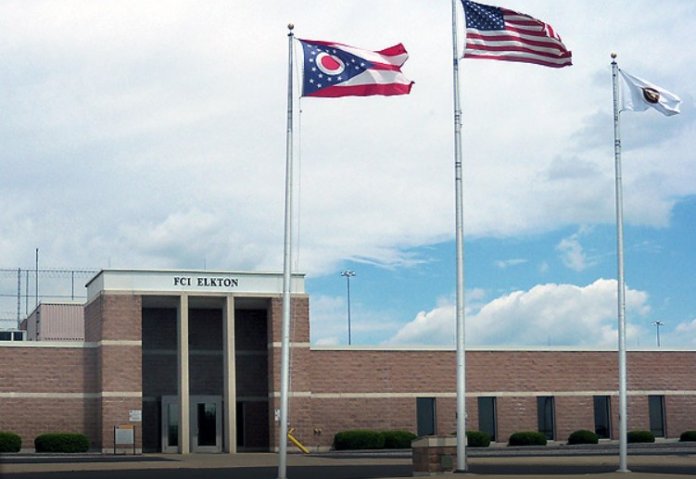Ohio Capital Journal
Union workers with the Ohio Department of Rehabilitation and Correction say they are not given proper personal protective equipment and that state officials have disregarded their concerns.
SEIU District 1199 — a union representing health care workers and staff members with ODRC — said in a press release that the state only supplies cloth facial coverings or surgical masks to prison employees, which are inferior to N-95 masks. N-95 masks, which greatly protect the wearer against COVID-19, are provided at the discretion of administrators and staff are being asked to reuse protective equipment, according to the release.
“Having the proper protective equipment is of the highest importance,” Joshua Norris, executive vice president for SEIU District 1199, said. “Staff members would be much more protected if they were properly equipped with N-95 respirators and face shields. … We believe there is not a strong justification for having workers go without them.”
Prison populations across the country have been hotspots for coronavirus, and SEIU District 1199 claims this, coupled with “harmful management decisions within ODRC facilities,” puts prison staff at heightened risks.
“These workers do not know who is positive in these facilities and who is not,” Anthony Caldwell, the union’s director of public affairs, said. “It is impossible for staff members to protect themselves without further mitigation. More must be done to protect them — they are heroes on the frontlines, but their voices are being disregarded.”
ODRC spokeswoman Sara French said the department was not aware staff were being forced to reuse their masks for multiple days, and added that new, disposable masks are provided each day. French said the department is following Ohio Department of Health guidelines.
In mid-March, the ODRC confirmed a staff member at Marion Correctional Institution tested positive for COVID-19. Over a month later, nearly 2,000 inmates and 150 staff at the facility tested positive for the virus. As of the department’s July 15 report, there were 77 confirmed COVID-19 related inmate deaths and five staff deaths across the states’ 27 prisons and affiliated medical centers.
In April, Ohio led the nation in confirmed cases among incarcerated persons, and it remains one of only a handful of states testing prison and jail populations, according to The Marshall Project. Gov. Mike DeWine has since petitioned the state to release nearly 200 inmates who are non-repeat and non-violent offenders and nearing their original release date.
An exploratory report from the American Civil Liberties Union (ACLU), in conjunction with a staff of epidemiologists, mathematicians and statisticians, projects 23,000 incarcerated people could die from COVID-19 nationwide if unmediated.
“Overcrowding, lack of access to hygiene, and substandard health care make jails and prisons potential time bombs for any outbreak, let alone the deadly coronavirus,” the ACLU report read.
“Correctional staff come to work every day and then return home,” it continued. “People are frequently brought in on arrest and released if they can pay bail or held for short stays. Any of these individuals can easily and unknowingly bring the virus into a jail, where infections can spread rapidly.”
While numbers of cases among inmates in Ohio’s prison system have plateaued, cases among staff have increased steadily since early June, according to The Marshall Project.
“… Conditions are now more hazardous than when they began to work from home,” Norris said. “With many safety concerns, large groups of inmates in quarantine, and nearly 100 lives lost, the health and safety concerns of these workers must be heard. Our members signed up to serve their fellow Ohioans but not to be casualties of a pandemic. We can’t forget them.”
***
House speaker floats baseless theory of ‘double counting’ COVID-19 cases
Ohio House Speaker Larry Householder, without evidence, floated a theory to reporters Thursday in which the Ohio Department of Health is counting some COVID-19 cases twice and some as many as 15 times.
Householder, R-Glenford, said he doesn’t necessarily believe the notion himself that ODH is inflating the data, but said there’s a lot of “controversy about how that information is gathered” and people are critical of it.
“I’m certain you’ve heard that there’s double countings and folks that even say some folks have been counted 15 times, they count every single positive test and if folks go in for more and more testing, they get counted every single time,” he said. “There’s always those criticisms.”
Householder, who does not wear a mask and has expressed skepticism about different aspects of the pandemic, said he believes ODH publishes accurate information about the pandemic, but he does “question it.” READ MORE
***
Ohio arrests thousands of drunken drivers in the face of far fewer deaths. Why not bust people for not following mask orders?
After weeks of reluctance, Ohio Gov. Mike DeWine on Thursday said that at least on a limited basis, he’d start enforcing mask-wearing orders in the Ohio counties hardest hit by coronavirus.
The governor also hinted that he might skip the Republican National Convention scheduled next month in Florida, which currently is the nation’s worst coronavirus hot spot.
But the governor repeated that he didn’t want to arrest anybody for not following mask orders aimed at slowing the spread of a pandemic that’s been much more deadly than drunken driving — for which thousands of Ohioans are arrested every year.
The recent news about the disease in Ohio has been bad and getting worse. On Thursday, the 24-hour counts for new coronavirus cases, hospitalizations, ICU admissions and deaths all were significantly over their 21-day averages. Also, state health officials moved six more counties into the “red” category, the second-highest level of alert. READ MORE





